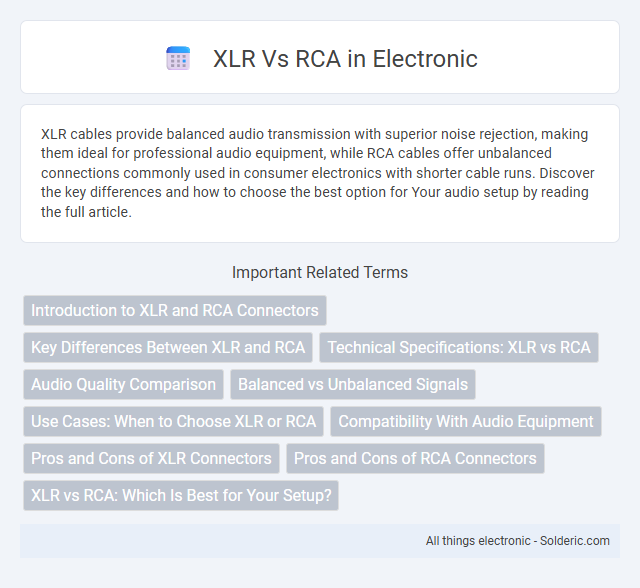XLR cables provide balanced audio transmission with superior noise rejection, making them ideal for professional audio equipment, while RCA cables offer unbalanced connections commonly used in consumer electronics with shorter cable runs. Discover the key differences and how to choose the best option for Your audio setup by reading the full article.
Comparison Table
| Feature | XLR | RCA |
|---|---|---|
| Connector Type | 3-pin balanced | Unbalanced coaxial |
| Signal Type | Balanced audio signal | Unbalanced audio signal |
| Use Case | Professional audio, microphones, mixers | Consumer audio, home theater, stereo devices |
| Noise Immunity | High - resists interference | Low - more prone to noise |
| Cable Length | Can exceed 100 meters without signal loss | Optimal under 6 meters to avoid degradation |
| Durability | Robust metal connector, lock mechanism | Plastic or metal, no locking |
| Phantom Power Support | Yes (for microphones) | No |
| Typical Signal Level | Mic or line level | Line level |
Introduction to XLR and RCA Connectors
XLR connectors, typically used in professional audio equipment, provide balanced audio signals that reduce noise and interference over long cable runs, making them ideal for microphones and high-quality sound systems. RCA connectors, commonly found in consumer electronics, carry unbalanced audio signals and are widely used for connecting devices such as DVD players, TVs, and stereo systems. Understanding the differences in signal type and application helps determine the best connector choice for specific audio setups.
Key Differences Between XLR and RCA
XLR connectors deliver balanced audio signals, significantly reducing noise and interference compared to the unbalanced RCA connectors. XLR cables are commonly used in professional audio, offering secure locking mechanisms and higher durability, while RCA connectors are prevalent in consumer electronics due to their simplicity and lower cost. The impedance and signal level differences between XLR and RCA impact sound quality, with XLR providing stronger signals suitable for long cable runs.
Technical Specifications: XLR vs RCA
XLR connectors feature a balanced three-pin design that reduces noise and interference, making them ideal for professional audio equipment requiring high-quality signal transmission. RCA connectors utilize an unbalanced single-ended design, which is more susceptible to signal degradation and electromagnetic interference, typically suited for consumer-grade audio systems. Your choice between XLR and RCA should consider the environment's noise level and the importance of maintaining audio fidelity.
Audio Quality Comparison
XLR connectors provide superior audio quality due to their balanced design, which effectively reduces electromagnetic interference and noise, resulting in clearer and more accurate sound reproduction. RCA connectors, being unbalanced, are more susceptible to signal degradation and interference over longer cable runs, which can lead to hums and signal loss. Professional audio environments prefer XLR connections for their reliability and ability to maintain high-fidelity audio integrity.
Balanced vs Unbalanced Signals
XLR connectors transmit balanced signals, which use two signal wires and a ground to reduce noise and interference over long cable runs, making them ideal for professional audio environments. RCA connectors carry unbalanced signals through a single signal wire and ground, making them more susceptible to noise, especially in electrically noisy settings or with longer cables. Choosing XLR can significantly improve your audio quality by minimizing signal degradation from interference.
Use Cases: When to Choose XLR or RCA
XLR connectors are ideal for professional audio environments requiring balanced signals, such as live sound, studio recording, and broadcasting, where minimizing noise interference is critical. RCA connectors work best for consumer electronics and home audio systems where unbalanced signals suffice for short cable runs and less susceptible environments. Choose XLR for longer cable distances and higher fidelity needs, while RCA fits your needs for cost-effective, simple stereo setups.
Compatibility With Audio Equipment
XLR connectors are primarily compatible with professional audio equipment such as microphones, mixers, and studio monitors, offering balanced audio signals that reduce noise and interference. RCA connectors are commonly used with consumer audio devices like home theater systems, televisions, and older audio interfaces, delivering unbalanced signals suitable for short cable runs. Choosing between XLR and RCA depends on the audio equipment's input/output compatibility and the need for signal integrity in different environments.
Pros and Cons of XLR Connectors
XLR connectors offer balanced audio signals, which significantly reduce noise and interference, making them ideal for professional audio equipment and long cable runs. Their robust, locking design ensures a secure connection, preventing accidental disconnections during performances or recordings. However, XLR cables and connectors tend to be bulkier and more expensive compared to RCA, potentially limiting flexibility in compact or budget setups.
Pros and Cons of RCA Connectors
RCA connectors offer simplicity and widespread compatibility with consumer audio devices, making them ideal for home entertainment systems. Their main drawbacks include susceptibility to noise interference and limited signal quality over long distances compared to balanced XLR connectors. RCA connectors are typically unbalanced, which can introduce hum and signal degradation in professional audio setups.
XLR vs RCA: Which Is Best for Your Setup?
XLR connectors offer balanced audio signals, reducing noise and interference, making them ideal for professional and long cable runs. RCA connectors provide unbalanced signals suited for short-distance consumer audio setups, delivering clear sound with affordability and simplicity. Your choice depends on whether you prioritize professional-grade audio quality and noise reduction (XLR) or cost-effective, straightforward connectivity (RCA).
XLR vs RCA Infographic

 solderic.com
solderic.com